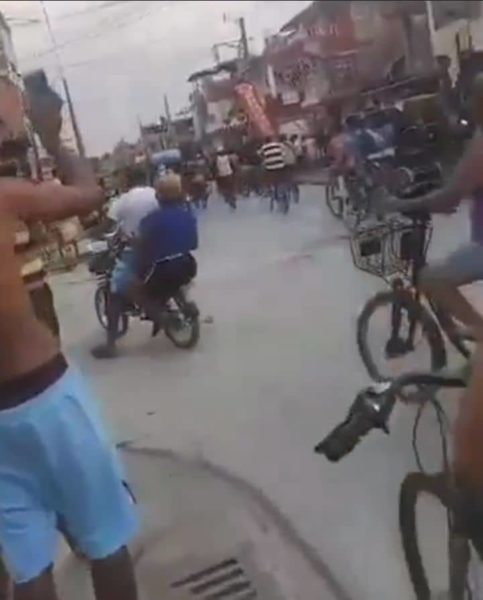Protests in Eastern Cuba Test the Government

By Javier Herrera
HAVANA TIMES – The past few weeks in Cuba have led the people to extremes of misery rarely seen or experienced before in the nation. Constant blackouts of up to 20 hours, widespread shortages with even rationed bread rolls missing, have pushed the population to the brink of exasperation.
Specifically, the lack of bread, milk, and other foods, as well as the lack of electricity, have hit the eastern part of the country particularly hard, affecting any city or town away from Havana. People in Santiago de Cuba, tired of oppression, took to the streets this Sunday, March 17, 2024.
On Sunday afternoon, chanting “Electricity and food,” the protesters in Santiago marched peacefully through the streets of their rebellious city. Among the shouts was the slogan “Patria y Vida” (“Homeland and Life”) could occasionally be heard, while the police, lacking superior orders, limited themselves to guarding the march, taking videos and notes. The head of the Communist Party of the province took refuge on a rooftop as the people sought her out to voice their complaints.
Strangely, the Cuban regime did not dare to unleash repression at first instance and, contrary to its customary behavior, reflected the protests in its political medium, CubaDebate, making it clear the peaceful nature of the demonstrations.

Apparently, according to the voice of the official media, the demonstration in Santiago was dismantled after the electricity was restored and trucks carrying food, including milk and items distributed through the ration book, arrived in a hurry. Meanwhile, a plane was loaded with food in Havana to distribute in the eastern provinces.
But Santiago de Cuba is not alone in misery, and soon other towns and cities in the region joined in, with similar protests in Bayamo, the rebellious capital of Granma province. Unlike Santiago, in Bayamo the protests were more radical and did not ask for food or electricity.

In the historic city of Bayamo, the people marched while singing the National Anthem and demanding freedom, the word most feared by the regime. Unlike Santiago, the demonstration in Bayamo cannot be placated by bringing them “a truck, or ten.” Like in Santiago de Cuba, the police have been slow to repress, which does not mean they have not done so, but at least the fierce and disproportionate confrontations seen during the July 11, 2021 demonstrations have not been observed.
At 10 p.m., various independent media continue to broadcast videos of the people of Bayamo in the streets demanding freedom. Meanwhile, there are various unconfirmed reports of demonstrations in other towns away from the capital, such as Caimanera in Guantánamo, Ciego de Avila, Holguín, or Artemisa.
These latest reports did not include videos or live broadcasts, which leads to doubts about their veracity, although it is also known that the government takes measures to cut off the internet or slow down the speed to prevent the spread of testimonies when such popular actions occur.
Meanwhile in Havana, there is a tense calm where the population follows the events through social media, some talk about taking to the streets and the regime parades its forces through the avenues in military trucks and takes arteries like the Malecon through improvised “parties” with recorded music and the sale of food and alcoholic beverages.
Another unusual government response has been expressed by President Miguel Diaz-Canel, who in the July 11, 2021 protests uttered the sad phrase “The combat order has been given,” unleashing repression and anger.
Taken from CubaDebate, the following excerpt shows the initial official government reaction, although it did not refrain from lying that the situation was being manipulated by “terrorist elements from Miami to harm the Revolution.”
The government’s initial statement:
Díaz-Canel assured that the disposition of the authorities of the Communist Party, the State, and the Government is to attend to the demands of the Cuban people. “Listen, dialogue, explain the numerous efforts being made to improve the situation, always in an atmosphere of tranquility,” reported the official Cubadebate website.
Finally, Díaz-Canel reaffirmed his government’s commitment to work peacefully to overcome the current situation, despite the US blockade that seeks to suffocate the nation.
“We will continue working in peace to get out of this situation,” concluded the president.
Once again, the regime faces protests demanding urgent solutions to situations that it has made clear on national television it cannot resolve in the short or medium term. Where the protests will end is still doubtful, but that they will be repeated is certain. The Cuban people are tired of living as they do, and the ruling elite knows it.
The solution lies in the hands of the government itself: dismantle what little remains of a revolution in which fewer and fewer people believe in every day, transition to a new type of government, and let the island and its population flourish and thrive. Delaying the decision only prolongs the suffering and leads us to a confrontation between the regime and the population that will not be beneficial for anyone.






Cuban communism is a failed social and economic experiment that followed the dead-end path of ‘delusional idealism.’ The goals were ideal but not practical in the real world, and in the process Cubans lost their basic freedoms: freedom of expression, freedom of movement, freedom of opportunity, freedom from government oppression and government over-control.
It was just such a path in the USSR that led to its collapse in the 90s. The only thing that kept Cuba from going belly up after the collapse was the outside threat by the USA and its embargo, which provided the perfect scapegoat for the communists in charge. “Your problems are a result of the ‘bloqueo'” was their mantra. And too many Cubanos bought it.
It is time for the Cubans to rise up as a people and absolutely demand a new form of government; one based on a democratic processes and free elections, and one that gives economic and political freedom to its citizens. The transitions will not be easy but this is the only way out of the quagmire of poverty and lack of economic opportunity that now plagues your island.
The economic problems of Cuba have been experienced and well documented in Russian/USSR history. The specifics were different as Cuba tried to develop an approach that would work for Cuba and respect Cuban values. But in the end, central economic planning can’t do the job.
The administration necessary to make informed decisions gets too large, they get bogged down in local decisions that they are not qualified to make and the result is poor productivity and excessive waste.
Adopting a more free market approach leads to better and faster decisions, innovation and the creation of new services that may be missing and the abandoning of non-productive, low productivity businesses and services.
Cuba, like Russia of the 50s to 80s, made reforms and improved some things but the reforms were only partial (Raul Castro did try.) As a result, internal inequalities and dissatisfaction emerged and overall productivity dropped.
To adopt more comprehensive economic reform and trust the “market” to make decisions does not mean a switch to capitalism and need not lead to gross inequalities as in the USA. There is a middle ground. Look at the Scandinavian countries. Preserving the commitment to socialist values and preserving what is wonderful about Cuba is possible while taking approaches to market reform as in other western countries should be possible. But it requires faith in the people.
A more free market approach could reduce administrative overheads, allow elected officials to focus on matters of national concern and productivity would increase to support Cuba’s many important values.
Democracy is going through a rough time with the US emergence of Trump and the MAGA movement. But it need not be so for Cuba if extreme inequality is controlled by progressive taxation and other measures.
It won’t happen overnight but it may restore hope and encourage other countries to work with Cuba while the US makes up its mind to drop the embargo.
Many of us love Cuba because of the people and the culture and want to see Cuba succeed. A commitment to full economic reform would give us hope too.
From the article ,
“dismantle what little remains of a revolution in which fewer and fewer people believe in every day, transition to a new type of government, and let the island and its population flourish and thrive.”
That is not simple, but it is straightforward and it will work , along with controlling drugs, crime and corruption.
If Cuba did that, the world will flock to help.
The government — which is hoping for a miracle to save the country — should start plans for a transition to a new government (with REAL change) , even if it is done in secret. Emulating Singapore would be a good move.
About the article: “Finally, Díaz-Canel reaffirmed his government’s commitment to work peacefully to overcome the current situation, despite the US blockade that seeks to suffocate the nation.
Washington and Havana restored diplomatic relations, but rebuilding mutual respect for copyrights, trademarks and other intellectual property is one of many still-pending issues .
In Cuba, the government puts Hollywood movies and TV shows on national television (without ads), and they do not pay the copyright holders anything. They have been doing this for decades at a cost of over a trillion dollars in loses to foreign countries!
Given this fact we can surmise some financial estimates and reconsider the so-called US embargo and who owes who.
The average US citizen pays $35-40 monthly for TV and film streaming and often much more! Here is a modest estimate of the financial values involved: a general snapshot.
Cuba’s population projections
can easily support an average of over 8 million over the last 40 years. This low and modest estimate means 320,000,000 million people in Cuba enjoying pirated US films. At $35.00 a month = $1,120,000,00 Cuba has refused to pay for stolen US films that have been pirated.
The actual amount in dollars is much much higher since the Cuban population has been over 10 million for some time!
Clearly, this giant rip off of US Canadian and other country’s films by the Cuban government reveals another perspective and deserves consideration.
Fair Market Value should dictate that the Cuban government compensates US , Canadian and other countries for what they have stolen under the guise of political protests.
Blockade? So while the Cuban government is busy pointing its’s fingers at USA and other countries, it is clear, there is a lot more to consider in any judgements.
In politics good will can lead to great diplomacy. The fact is even Canada, who helped Cuba for so many years experienced the same film pirating clearly proves the problem is not solely confined to USA. Outright theft, it seems the Cuban government is more proud than anything else as they falsely claim that the USA embargo is the justification.
The apple does not fall far from the tree: no wonder common theft is rampant in Cuba as the government of Cuba has modelled public behaviour.
Washington Post: None of it is properly licensed or paid for by Cuba, whose government has had little compunction about pirating good programming from a longtime foe with a vast legislative apparatus designed to choke its economy.
Washington and Havana restored diplomatic relations, but rebuilding mutual respect for copyrights, trademarks and other intellectual property is one of many still-pending
US blockade that seeks to suffocate Cuba! ? There are two sides to the equation and the truth is?
Just an observation ….worth considerstion?
Well change is needed and only come at huge cost. I wonder how many people will get injured or put in jail or killed in the process. Other countries I believe are tired of helping out cuba without a new economic model
I just hope that cuba can keep free Healthcare and free education to grade 12 and doesn’t bring companies like walmart and uses the model of distribution to smaller businesses of costco type .